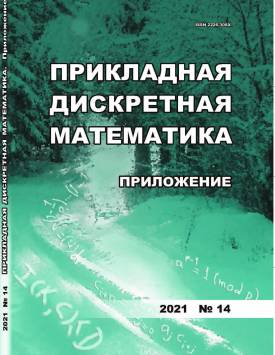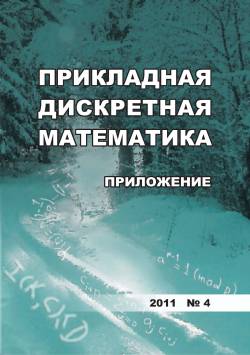On privacy in decentralized systems with tokens
A three-level model of a decentralized system is proposed, the level with protocols for the creation and validation of private transactions is highlighted. The main feature of ensuring the transaction privacy in decentralized systems with tokens is the need to validate the various conditions for the transaction content without access to it. Therefore, classes of non-classical (and non-standardized in the Russian Federation) cryptographic mechanisms, which are often used in decentralized systems with private transactions, are highlighted. The non-universality of the existing formal definitions of such systems is shown. Therefore, formalizing the transaction privacy property in the general case is an open problem.
Keywords
ring signature,
commitment,
aggregate signature,
homomorphic encryption,
zero know ledge proof,
token,
privacy,
decentralized systemAuthors
| Akhmetzyanova L. R. | LLC "CRYPTO-PRO" | lah@cryptopro.ru |
| Babueva A. A. | LLC "CRYPTO-PRO" | babueva@cryptopro.ru |
| Kyazhin S. N. | Sberbank of Russia | blockchain-research@sberbank.ru |
| Popov V. A. | Sberbank of Russia | blockchain-research@sberbank.ru |
Всего: 4
References
Молдовян Н. А. Теоретический минимум и алгоритмы цифровой подписи. СПб.: БХВ-Петербург, 2010. 304с.
Межгосударственный стандарт ГОСТ 34.10-2018 «Информационная технология. Криптографическая защита информации. Процессы формирования и проверки электронной цифровой подписи». М.: Стандартинформ, 2018.
Mitani T. and Otsuka A. Confidential and auditable payments // LNCS. 2020. V. 12063. P. 466-480.
Guan Z., Wan Z., Yang Y., et al. BlockMaze: An efficient privacy-preserving account-model blockchain based on zk-SNARKs // IEEE Trans. Dependable Secure Comput. IEEE, 2020. https://eprint.iacr.org/2019/1354.pdf.
Canetti R. Universally composable security: a new paradigm for cryptographic protocols // 42nd IEEE Symp. Found. Comput. Sci. IEEE, 2001. P. 136-145.
Cremers C. and Mauw S. Operational Semantics and Verification of Security Protocols. Springer Verlag, 2012. 174 p.
Brandenburger M., Cachin C., Kapitza R., and Sorniotti A. Blockchain and trusted computing: Problems, pitfalls, and a solution for Hyperledger Fabric. 2018. https://arxiv. org/pdf/1805.08541.pdf
Hevia A. Introduction to Provable Security. Advanced Crypto School, Florianopolis, 2013.
Zhang W. and Ma B. Blockchain Data Protection using Homomorphic Encryption. US Patent 2019/0253235 A1.
Cheng R., Zhang F., Kos J., et al. Ekiden: A platform for confidentiality-preserving, trustworthy, and performant smart contracts // IEEE Europ. Symp. Security Privacy. 2019. P. 185-200.
Fuchsbauer G., Orru M., and Seurin Y. Aggregate cash systems: a cryptographic investigation of Mimblewimble // LNCS. 2019. V. 11476. P. 657-689.
Bunz B., Agrawal S., Zamani M., and Boneh D. Zether: Towards privacy in a smart contract world // LNCS. 2020. V. 12059. P. 423-443.
Poelstra A. Mimblewimble. 2016. https://download.wpsoftware.net/bitcoin/wizardry/mimble-wimble.pdf
AZTEC Protocol. 2018. https://github.com/AztecProtocol/AZTEC/blob/master/AZTEC. pdf
CryptoNote v 2.0. 2013. https://cryptonote.org/whitepaper.pdf
Yuen T. H., Sun S.-F., Liu J. K., et al. RingCT 3.0 for blockchain confidential transaction: Shorter size and stronger security // LNCS. 2020. V. 12059. P. 464-483.
Ben Sasson E., Chiesa A., Garman C., et al. Zerocash: Decentralized anonymous payments from bitcoin // IEEE Symp. Security Privacy. San Jose, CA, 2014. P. 459-474.
Zcash Protocol Specification. 2021. https://github.com/zcash/zips/blob/master/protocol/protocol.pdf
Pass R., Seeman L., and Shelat A. Analysis of the blockchain protocol in asynchronous networks // EUROCRYPT 2017. Springer, 2017. P. 643-673.
Nijsse J. and Litchfield A. A taxonomy of blockchain consensus methods // Cryptography. 2020. V. 4. No. 4. Art. 32. 15 p.
Sai A. R., Buckley J., Fitzgerald B., and Le Gear A. Taxonomy of Centralization in Public Blockchain Systems: A Systematic Literature Review. 2020. https://arxiv.org/pdf/2009. 12542.pdf
Zhang R., Xue R., and Liu L. Security and privacy on blockchain // ACM Computing Surveys. 2019. V. 52. No. 3. Art. 51. 34 p.
Методические рекомендации ТК 26 МР 26.4.001-2018 «Информационная технология. Криптографическая защита информации. Термины и определения в области технологий цепной записи данных (блокчейн) и распределенных реестров». М.: Технический комитет по стандартизации «Криптографическая защита информации», 2018.

